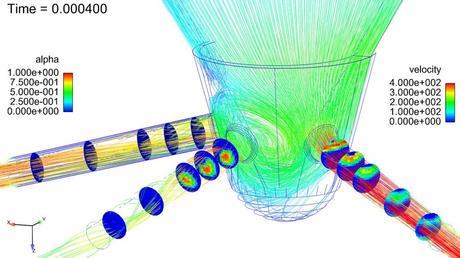 Caterpillar and Argonne National Laboratory undertake cooperative virtual engine design project. (Credit: Flickr @ Jaix Chaix https://www.flickr.com/photos/101446152@N07/)
Caterpillar and Argonne National Laboratory undertake cooperative virtual engine design project. (Credit: Flickr @ Jaix Chaix https://www.flickr.com/photos/101446152@N07/)Caterpillar and Argonne National Laboratory along with Convergent Science, a software company, have entered into an agreement to develop new engine combustion models that incorporate accurate descriptions of two-phase flows, chemistry, transport phenomena and device geometries.
Internal combustion engines are poised for dramatic breakthroughs in improving efficiency with lower emissions, thanks in part to low-temperature combustion regimes. Such regimes show great efficiency and emissions potential, but they present optimization and control challenges that must be addressed before they enter the engine mainstream.
SEE ALSO: New Method Could Halve Fuel Consumption for Gasoline Engines

Experts are developing new engine combustion models that incorporate accurate descriptions of two-phase flows, chemistry, transport phenomena and device geometries to provide predictive simulations of engine and fuel performance. (Credit: Argonne National Laboratory)
Cat anticipates that simulations developed by researchers at Argonne National Laboratory and its Virtual Engine Research Institute and Fuels Initiative (VERIFI) will reduce the time and cost of the design cycle for new engines, allow the rapid adaptation of fuels from new sources and lead to substantial increases in fuel economy while meeting future emissions standards. “Working with Argonne researchers will provide us access to their high-performance computing facilities and expertise in spray and combustion modeling that will improve our simulation practices at Caterpillar,” said Marcus Weber, team leader at Caterpillar.
Convergent Science is a world leader in computational fluid dynamics (CFD) software development. The company’s flagship product, CONVERGE, is used for CFD simulations in many industries. The staff at Convergent Science are experts in CFD simulations, numerical methods, model development and implementation and were instrumental in adapting high-performance computing practices in the CONVERGE code.
VERIFI applies state-of-the-art tools in high-performance computing, combustion chemistry, CFD, and experimental validation techniques to develop high-fidelity, three-dimensional, end-to-end, combustion engine simulation/visualization and fuel simulation. Advances in high-performance computing enable VERIFI researchers to run engine simulations in parallel on thousands, or even hundreds of thousands of processors. While efficient scaling of engine simulations to such massively parallel machines remains a significant challenge, such calculations will ultimately allow not only the rapid engineering of specific engine designs, fuels and operation conditions, but also allow their optimization.

